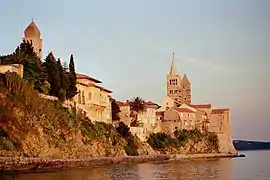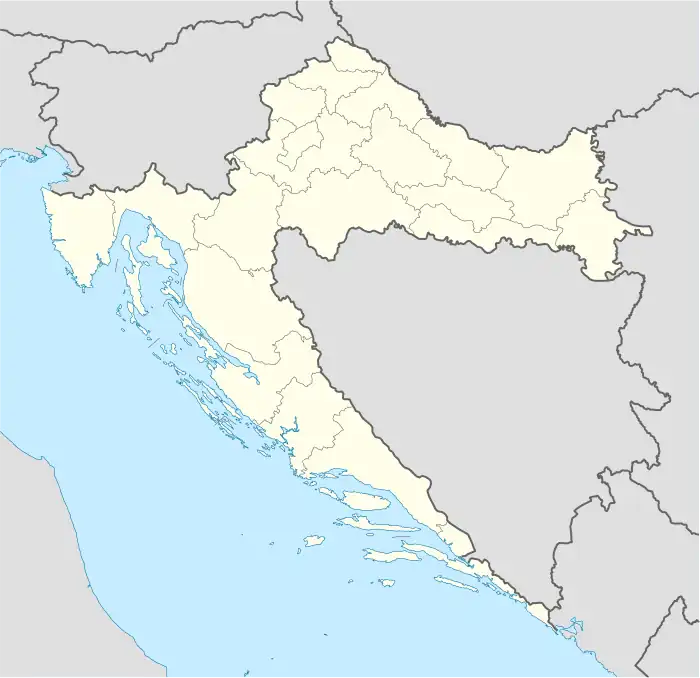Rab | |
|---|---|
Town | |
 Historic town center of Rab | |
 Rab Location of Rab within Croatia | |
| Coordinates: 44°45′22″N 14°45′40″E / 44.75611°N 14.76111°E | |
| Country | |
| County | |
| Island | Rab |
| Government | |
| • Mayor | Nikola Grgurić (HDZ) |
| • City Council | 15 members |
| Area | |
| • Town | 75.9 km2 (29.3 sq mi) |
| • Urban | 0.4 km2 (0.2 sq mi) |
| Elevation | 0 m (0 ft) |
| Population (2021)[2] | |
| • Town | 7,161 |
| • Density | 94/km2 (240/sq mi) |
| • Urban | 364 |
| • Urban density | 910/km2 (2,400/sq mi) |
| Time zone | UTC+1 (CET) |
| • Summer (DST) | UTC+2 (CEST) |
| Postal code | 51 280 |
| Area code | 051 |
| Website | rab |
Rab (Italian: Arbe, Latin: Arba) is a town (grad) on the island of Rab in Croatia. According to the 2011 census the total population of the town was 8,065, whereas only 437 lived in the titular settlement (naselje). Rab, the settlement, is located on a small peninsula on the southwestern side of the island.
The town has a long history that dates back to 360 BC when it was inhabited by the Illyrians. The island was the frontier between the regions of Liburnia and Dalmatia. From the third century BC to the sixth century AD Rab was part of the Roman Empire, and Emperor Augustus proclaimed it a municipium in 10 BC. It was the first town of Roman Dalmatia to be given the honorary title "felix".
Among the signatories of the Second Council of Nicea was a bishop of Rab, namely Ursus. (“Ursus episcopus Avaritianensium ecclesiae” Ursus of Rab)[3][4]
The worst disaster in the town's history was an outbreak of the plague in 1456 that decimated the city's population.
There are many churches in the town. The largest is St. Mary the Blessed, which was built in the 13th century. The church of St. Justine is now a museum of sacred arts, while the chapel of St. Christopher (dedicated to the patron saint of the island) is nowadays called the Lapidarium. The four church bell towers became the symbol of the town and island. The oldest dates back to the eleventh century.
Saint Marinus, the Christian founder of San Marino, was a native of Rab who is said to have fled the island under Diocletian's persecution in AD 301.
Population
| population | 3589 | 3952 | 4279 | 4525 | 4465 | 5099 | 5099 | 6352 | 7230 | 7757 | 7849 | 8041 | 8496 | 9205 | 9480 | 8065 | 7161 |
| 1857 | 1869 | 1880 | 1890 | 1900 | 1910 | 1921 | 1931 | 1948 | 1953 | 1961 | 1971 | 1981 | 1991 | 2001 | 2011 | 2021 |
Gallery
 View of Rab from air
View of Rab from air Statue of San Marino
Statue of San Marino Streets of Rab
Streets of Rab Old Town
Old Town Ivan Dominis Promenade
Ivan Dominis Promenade Arbiana Hotel
Arbiana Hotel
References
- ↑ Register of spatial units of the State Geodetic Administration of the Republic of Croatia. Wikidata Q119585703.
- ↑ "Population by Age and Sex, by Settlements, 2021 Census". Census of Population, Households and Dwellings in 2021. Zagreb: Croatian Bureau of Statistics. 2022.
- ↑ Basić, Ivan (2018). New evidence for the re-establishment of the Adriatic dioceses in the late eighth century. Oxford. pp. 261–287. ISBN 978-1-138-22594-7.
{{cite book}}: CS1 maint: location missing publisher (link) - ↑ Škegro, Ante. The Sarnian diocese (Sarniensis Ecclesia) (PDF).
External links
Attribution
- The original version of this article was taken from the Wikipedia article Rab.
